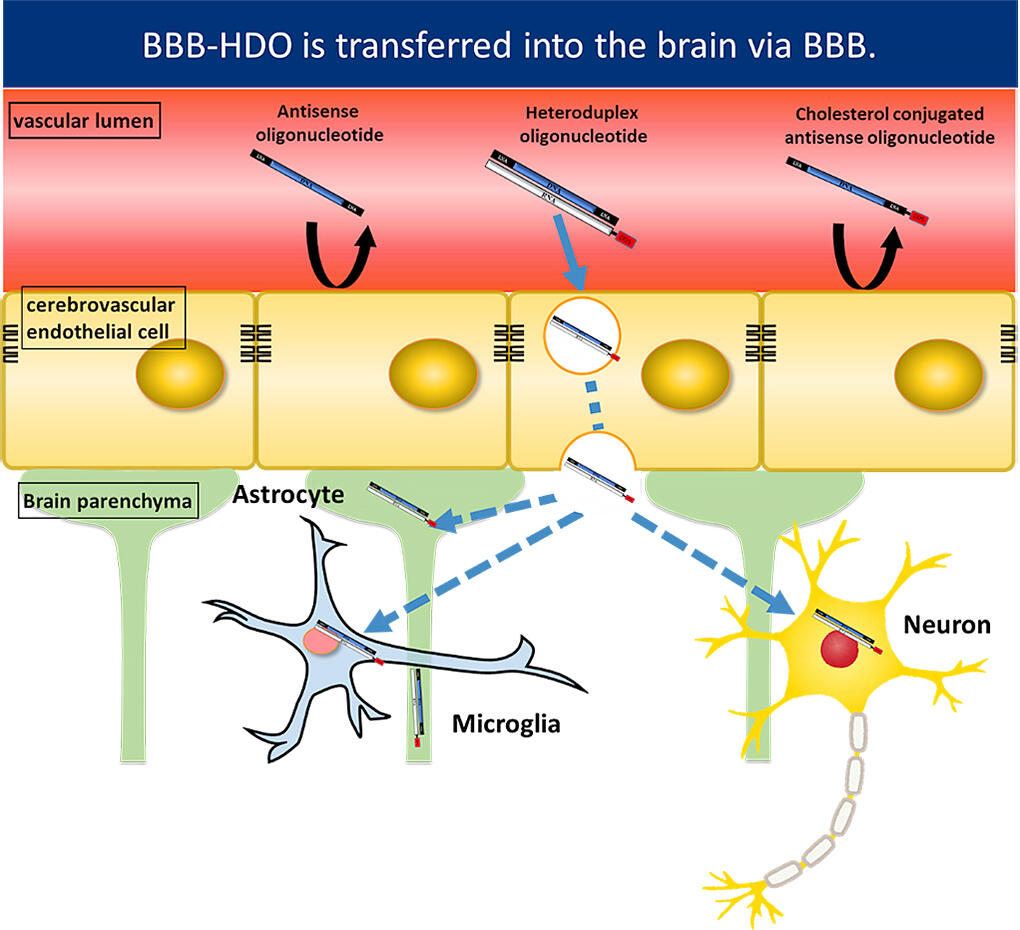In collaboration with Ionis Pharmaceuticals and Takeda Pharmaceutical Company Limited, Professor Takanori Yokota and Associate Project Professor Tetsuya Nagata of the Graduate School of Medical and Dental Sciences, Tokyo Medical and Dental University, developed a heteroduplex oligonucleotide that can cross the blood-brain barrier (BBB), which conventional nucleic acid drugs failed to bypass efficiently. Intravenous or subcutaneous administration of the developed oligonucleotide drug can suppress gene expression in the central nervous system (CNS). Although a nucleic acid drug for spinal muscular atrophy has been approved and radical treatment for intractable neurological diseases is now a possibility, the burden on patients was extremely high, as direct intrathecal administration had to be administered over the entire lifetime. The developed technology would allow self-injection, such as into the subcutaneous region. Professor Yokota has stated, "On application to some heteronucleic acid drugs available on the market, we confirmed a markedly strong gene-suppressing effect, ranging from 5- to 100-fold (approximately 20 times on average). Collaborative research with multiple pharmaceutical companies to assess their potential in diseases, including Alzheimer's disease, is ongoing." These findings have been published in Nature Biotechnology.
Nucleic acid pharmaceuticals are advanced biopharmaceutical technologies that enable selective control of target RNAs, which cannot easily be achieved with conventional small molecule compounds and antibody pharmaceuticals. In the past 3 years, 15 nucleic acid drugs have been approved for neurological and muscular diseases, including spinal muscular atrophy, familial amyloid polyneuropathy, and Duchenne's muscular dystrophy. Clinical trials evaluating therapeutics forseveral CNS diseases, including amyotrophic lateral sclerosis, Parkinson's disease, and Alzheimer's disease, are ongoing. However, for treating CNS disease, direct intrathecal administration via lumbar injection is required.
Nucleic acid drugs, such as conventional antisense nucleic acids and siRNA, cannot cross the BBB when administered systemically, and therefore fail to reach the central nervous system, such as the brain and spinal cord. During intrathecal administration, a long needle is inserted into the back and reaches the cerebrospinal fluid around the spinal cord through the gap in the lumbar spine. This administration method is challenging in patients receiving anticoagulant treatment, common in elderly individuals, as well as in those with scoliosis, an intractable neurological disease. Moreover, infection or bleeding can occur in rare cases. The research group has independently developed a DNA/RNA heteroduplex nucleic acid that is highly effective and exhibits a molecular structure that differs from conventional nucleic acid drugs, with various delivery molecules and a unique intracellular action mechanism. However, modulating brain functions with these agents remained challenging. Therefore, various lipid delivery molecules (ligands) were attached to the complementary strand, and these newly generated strands were screened to assess their ability to bypass the BBB.
As a result, the researchers observed that on binding cholesterol to a strand prior to intravenous administration in mice, it dramatically suppressed target RNAs in the CNS. Multiple doses afforded an additive and enhanced effect. In contrast, conventional single-stranded antisense nucleic acid drugs failed to suppress gene expression in the CNS, both after single and multiple administrations. In addition, on examination of nucleic acids exhibiting direct cholesterol-binding via a single-stranded antisense nucleic acid, the effect was weak and induced high levels of toxicity. Intravenous administration of the developed BBB-crossing heteroduplex oligonucleotide confirmed delivery to the CNS and gene suppressive effects on various target RNAs in the CNS.

On performing an in-depth examination in nerve and various glial cells, gene expression was inhibited potently, especially in nerve cells and microglia. Using a confocal laser scanning microscope, live images revealed clear translocation of the BBB-crossing heteroduplex nucleic acids into the brain. In addition to intravenous administration, subcutaneous administration also suppressed gene expression in the CNS. As a result, self-injection by subcutaneous administration is now feasible, avoiding the need to visit a medical institution for every dose. This affords considerable benefits to patients' convenience and quality of life.
This article has been translated by JST with permission from The Science News Ltd.(https://sci-news.co.jp/). Unauthorized reproduction of the article and photographs is prohibited.




